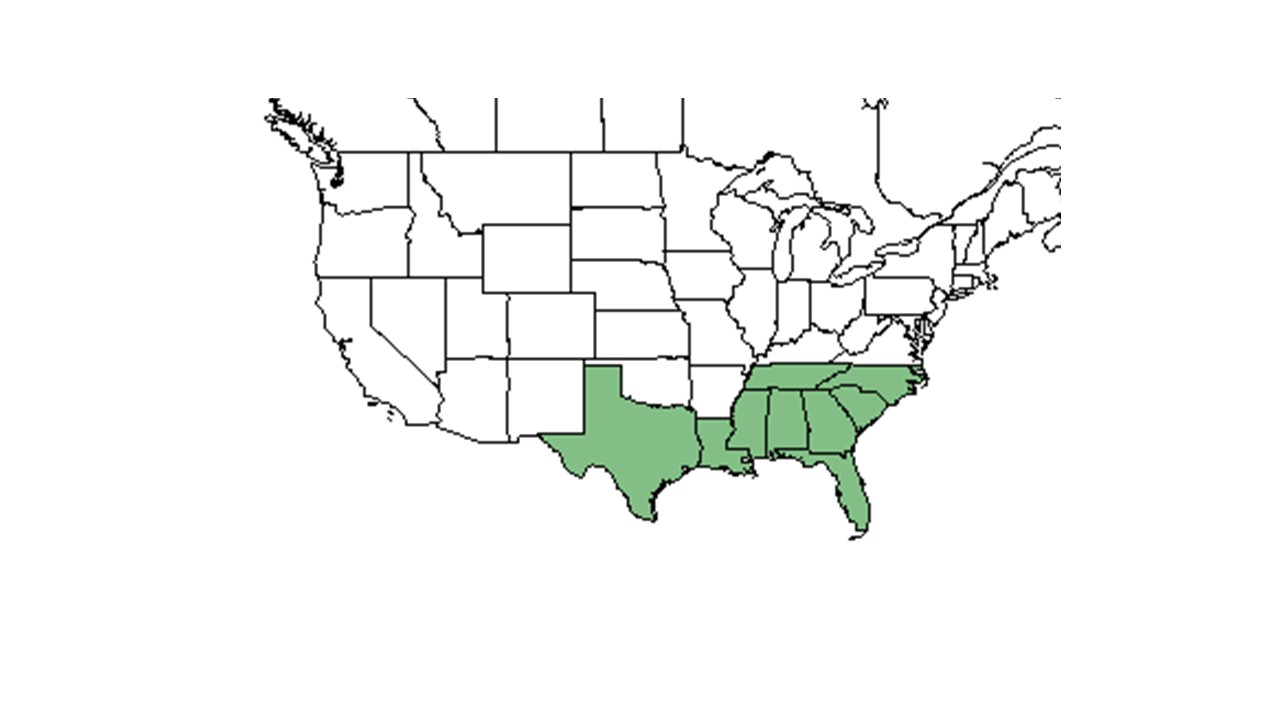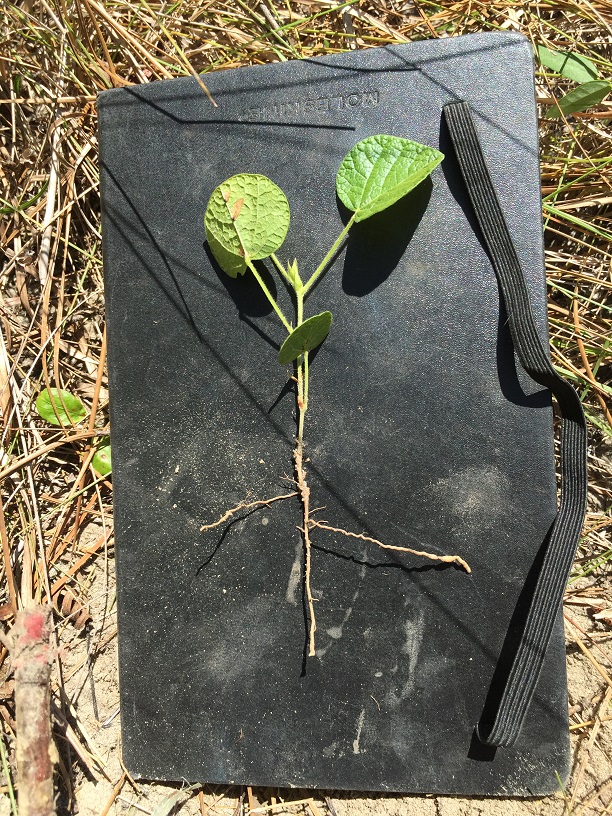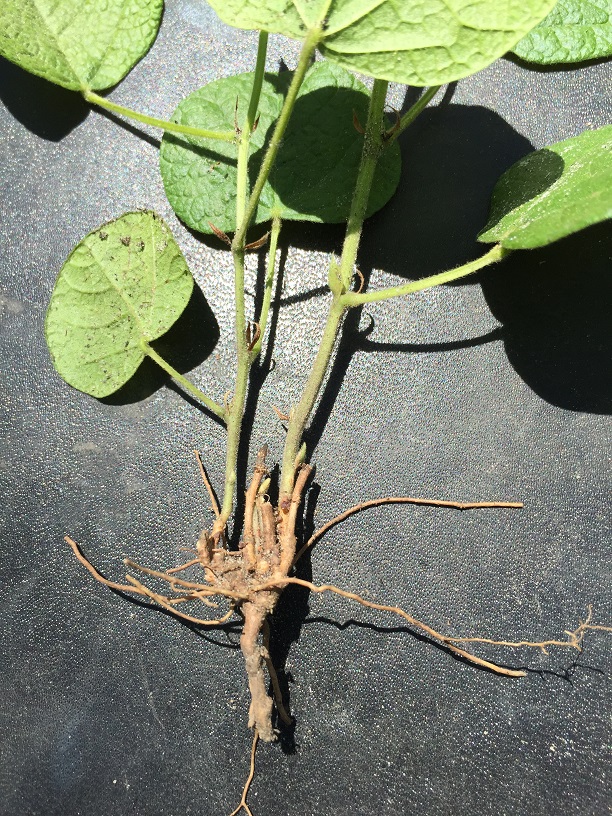Rhynchosia reniformis
| Rhynchosia reniformis | |
|---|---|

| |
| Photo was taken by Gil Nelson | |
| Scientific classification | |
| Kingdom: | Plantae |
| Division: | Magnoliophyta - Flowering plants |
| Class: | Magnoliopsida - Dicotyledons |
| Order: | Fabales |
| Family: | Fabaceae |
| Genus: | Rhynchosia |
| Species: | R. reniformis |
| Binomial name | |
| Rhynchosia reniformis DC. | |

| |
| Natural range of Rhynchosia reniformis from USDA NRCS Plants Database. | |
Common names: Dollarleaf (Nelson 2005), Dollarweed
Contents
Taxonomic notes
Synonym: Rhynchosia simplicifolia (Walter) Wood
Description
“Erect, trailing or climbing, perennial herbs or shrubs. Leaves pinnately 3-foliolate or occasionally 1-foliolate; leaflets usually entire and often bearing amber glands, usually estipellate; stipules ovate to lanceolate. Flowers papilionaceous, rarely solitary or in pairs but usually in axillary or occasionally also terminal racemes, several to numerous, loose to compactly clustered, pedicellate, each subtended by a caduceus bract. Calyx tube campanulate or tubular, nearly regular, lobes equal or nearly so in size but with the 2 uppermost partially united; petals yellow in ours, often equaling or even shorter than the calyx; stamens diadelphous, 9 and 1. Legume usually oblong and flattened, 1-2 seeded, dehiscent."[1]
"Erect herb 0.5-2.5 dm tall with strongly angled, densely short-pubescent stems. Leaves mostly 1-foliolate or rarely the lowermost 3-foliolate; leaflets suborbicular to reniform, 2-5 cm long, usually wider than long, thick and conspicuously reticulate, sparsely to densely pubescent especially along the veins on both surfaces, inconspicuously beset with numerous, minute, amber glands above and below, stipels persistent, 1.5-2.5 mm long; stipules persistent, linear-lanceolate, 5-10 mm long. Racemes axillary and terminal, sessile or peduncles to 2 cm long with rachises mostly 1-3 cm long, with numerous, closely clustered flowers on pedicels 1.5-3 mm long each subtended by a linear-subulate bract 3-5 mm long. Calyx densely hirsute to villous with numerous, inconspicuous, amber glands, tube 1.5-2 mm long, lobes subequal, lanceolate, 6-9 mm long, long-acuminate to subulate; petals yellow, 6-8 mm long. Legume 1-1.8 cm long, 5-7 mm broad, densely short-pubescent, inconspicuously glandular."[1]
The root system of Rhynchosia reniformis includes stem tubers which store non-structural carbohydrates (NSC) important for both resprouting following fire and persisting during long periods of fire exclusion.[2] Diaz-Toribio and Putz (2021) recorded this species to have an NSC concentration of 50.7 mg/g (ranking 75 out of 100 species studied).[2]
According to Diaz-Torbio and Putz (2021), Rhynchosia reniformis has stem tubers with a below-ground to above-ground biomass ratio of 0.375 and nonstructural carbohydrate concentration of 50.7 mg g-1.[3]
Distribution
R. reniformis is found throughout longleaf pine habitat in a variety of soil types across the southeast from North Carolina to Florida to Texas.[4][5][6][7]
Ecology
Habitat
In the Coastal Plain region, R. reniformis can be found in burned longleaf pine-wiregrass stands, burned upland longleaf pine forests, loamy sands of longleaf pine-oak scrubs, sandhills, savannas, sandy open areas, sandpine flatwoods, pineflatwoods on limerock, recently burned scrubs of cutover pinewoods, and turkey oak sand ridges.[8][9] It can also be found in open powerlines, clobbered slash pine forests, fallow longleaf pine-scrub oaks, and railroad embankments.
R. reniformis has shown regrowth in reestablished longleaf pine communities that were disturbed by agriculture in South Carolina, making it a possible indicator species for post-agricultural woodlands.[10] It became absent in response to military training in west Georgia longleaf pine forests. It has shown resistance to regrowth in reestablished pine forests that were disturbed by this activity.[11]
Associated species include Galactia mollis, Desmodium floridanum, Desmodium strictum, R. tomentosa, Pinus palustris, Aristida stricta, slash pine, sand pine, Lactuca floridana, Serenoa repens, turkey oak, Acanthospermum, Polygala and Onosmodium.[8]
Soil types include dry sand, sandy loam, loamy sand, limerock and gravelly sand.[8]
Rhynchosia reniformis is an indicator species for the North Florida Subxeric Sandhills community type as described in Carr et al. (2010).[12]
Phenology
R. reniformis has been observed flowering from April to September with peak inflorescence in May.[9][13]
Seed dispersal
This species is thought to be dispersed by consumption by vertebrates.[14]
Fire ecology
Rhynchosia reniformis is a legume found in frequently burned longleaf pine savannas.[15][16] Populations have been known to persist through repeated annual burns.[17][18]
A study describing the effects of a seasonal fire regime on legume reproduction in longleaf pine savannas found that R. reniformis produced the greatest number of flowers after a lightning season burn (44.0) and decreased after a late winter/early spring burn (21.5) and after an instance of no fire (21.4).[19] This study also found that the duration of synchronous flowering was greatest after a lightning season burn (190.0 days) and decreases after an instance of no fire (175.0 days) and after a late winter/early spring burn (149.0 days).[20] Additionally, peak flowering activity occurred earliest after an instance of no fire (190.7 Julian) with peak flowering occurring later after a lightning-season burn (196.3 Julian) and after a late winter/early spring burn (197.7 Julian).[21] R. reniformis was observed to resprout one month after a fire in July of 1993.[22] In a burning x no shade treatment, R. reniformis was found to have elevated levels of N2-fixation.[16] Herbivory damage for R. reniformis does not increase with time since fire. [23]
Herbivory and toxicology
The seeds of R. reniformis are a food source for the bobwhite quail, songbirds, and small mammals, and white-tailed deer forage on the plant.[24][25][26][27]
Conservation, cultivation, and restoration
It is recommended to collect seeds in mid-June to maximize seed germination rates.[28] Seeds have been successfully germinated after collection following dormant season burning and placement in germination trays (closed plastic germination boxes with seeds on moist blotting paper) located indoors at room temperature and in growing trays (in standard horticultural trays filled with moist sand) placed outside and exposed to natural fluctuations in temperature beginning one month following collection.[28]
Cultural use
Photo Gallery
References and notes
- ↑ 1.0 1.1 Radford, Albert E., Harry E. Ahles, and C. Ritchie Bell. Manual of the Vascular Flora of the Carolinas. 1964, 1968. The University of North Carolina Press. 636. Print.
- ↑ 2.0 2.1 Diaz-Toribio, M.H. and F. E. Putz 2021. Underground carbohydrate stores and storage organs in fire-maintained longleaf pine savannas in Florida, USA. American Journal of Botany 108: 432-442.
- ↑ Diaz‐Toribio, M. H. and F. E. Putz. 2021. Underground carbohydrate stores and storage organs in fire‐maintained longleaf pine savannas in Florida, USA. American Journal of Botany 108(3):432-442.
- ↑ Denhof, Carol. 2020. Plant Spotlight Rhynchosia reniformis DC. Dollarleaf Legume Family - Fabaceae. The Longleaf Leader. Vol. XIII, Issue 2. Pg. 7
- ↑ Miller, J.H. and K.V. Miller. 2005. Forest Plants of the Southeast and their Wildlife Uses. The University of Georgia Press. Athens, GA. 454pp.
- ↑ USDA, NRCS. 2020. The PLANTS Database (http://plants.usda.gov, 11 February 2-2-). National Plant Data Team, Greensboro, NC 27401-4901 USA.
- ↑ Sorrie, B.A. 2011. A field Guide to Wildflowers of the Sandhills Region: North Carolina, South Carolina, and Georgia. The University of North Carolina Press. Chapel Hill, NC. 378pp.
- ↑ 8.0 8.1 8.2 Florida State University Robert K. Godfrey Herbarium database. URL: http://herbarium.bio.fsu.edu. Last accessed: July 2015. Collectors: Loran C. Anderson, Robert L. Lazor, Steve L. Orzell, Edwin L. Bridges, Gary R. Knight, James R. Burkhalter, R.K. Godfrey, A. F. Clewell, Cheryl Vaughan, Robert Kral, Mable Kral, Gwynn W. Ramsey, R. S. Mitchell, Travis MacClendon, Karen MacClendon, Rodie White, Walter Kittredge, Kevin Oakes, Richard R. Clinebell II, Clarke Hudson, Charles M. Allen, Cecil R Slaughter, H. R. Reed, A. B. Seymour, F. S. Earle, S. B. Jones, Carleen Jones, S. W. Leonard, A. E. Radford, Henrietta Laing, Delzie Demaree, Lisa Keppner. States and Counties: Florida: Baker, Calhoun, Clay, Dade, Escambia, Flagler, Franklin, Gadsden, Hernando, Highlands, Jackson, Jefferson, Lee, Leon, Levy, Liberty, Madison, Okaloosa, Santa Rosa, St. Johns, Seminole, Suwannee, Union, Wakulla, Walton, Washington. Georgia: Baker, Grady, Seminole, Thomas. Mississippi: Clarke, Harrison, Ocean Springs, Pearl River, Pike. Louisiana: Allen. North Carolina: Harnett, Moore. Compiled by Tall Timbers Research Station and Land Conservancy.
- ↑ 9.0 9.1 Nelson, Gil. East Gulf Coastal Plain. a Field Guide to the Wildflowers of the East Gulf Coastal Plain, including Southwest Georgia, Northwest Florida, Southern Alabama, Southern Mississippi, and Parts of Southeastern Louisiana. Guilford, CT: Falcon, 2005. 184. Print.
- ↑ Brudvig, L.A., E Grman, C.W. Habeck, and J.A. Ledvina. (2013). Strong legacy of agricultural land use on soils and understory plant communities in longleaf pine woodlands. Forest Ecology and Management 310: 944-955.
- ↑ Dale, V.H., S.C. Beyeler, and B. Jackson. (2002). Understory vegetation indicators of anthropogenic disturbance in longleaf pine forests at Fort Benning, Georgia, USA. Ecological Indicators 1(3):155-170.
- ↑ Carr, S.C., K.M. Robertson, and R.K. Peet. 2010. A vegetation classification of fire-dependent pinelands of Florida. Castanea 75:153-189.
- ↑ Nelson, G. PanFlora: Plant data for the eastern United States with emphasis on the Southeastern Coastal Plains, Florida, and the Florida Panhandle. www.gilnelson.com/PanFlora/ Accessed: 13 DEC 2016
- ↑ Kirkman, L. Katherine. Unpublished database of seed dispersal mode of plants found in Coastal Plain longleaf pine-grasslands of the Jones Ecological Research Center, Georgia.
- ↑ Brewer, J. S. and S. P. Cralle 2003. Phosphorus addition reduces invasion of a longleaf pine savanna (southeastern USA) by a non-indigenous grass (Imperata cylindrica). Plant Ecology 167: 237-245.
- ↑ 16.0 16.1 Hiers, J. K. and R. J. Mitchell 2007. The influence of burning and light availability on N-2-fixation of native legumes in longleaf pine woodlands. Journal of the Torrey Botanical Society 134: 398-409.
- ↑ Robertson, K.M. Unpublished data collected from Pebble Hill Fire Plots, Pebble Hill Plantation, Thomasville, Georgia.
- ↑ Platt, W.J., R. Carter, G. Nelson, W. Baker, S. Hermann, J. Kane, L. Anderson, M. Smith, K. Robertson. 2021. Unpublished species list of Wade Tract old-growth longleaf pine savanna, Thomasville, Georgia.
- ↑ Hiers, J. K., et al. (2000). "The effects of fire regime on legume reproduction in longleaf pine savannas: is a season selective?" Oecologia 125: 521-530.
- ↑ Hiers, J. K., et al. (2000). "The effects of fire regime on legume reproduction in longleaf pine savannas: is a season selective?" Oecologia 125: 521-530.
- ↑ Hiers, J. K., et al. (2000). "The effects of fire regime on legume reproduction in longleaf pine savannas: is a season selective?" Oecologia 125: 521-530.
- ↑ Pavon, Milton Lara (1995). "Diversity and response of ground cover arthropod communities to different seasonal burns in longleaf pine forests." A Master's thesis.
- ↑ Knight, T. M. and R. D. Holt 2005. Fire generates spatial gradients in herbivory: an example from a Florida sandhill ecosystem. Ecology 86: 587-593.
- ↑ Denhof, Carol. 2020. Plant Spotlight Rhynchosia reniformis DC. Dollarleaf Legume Family - Fabaceae. The Longleaf Leader. Vol. XIII, Issue 2. Pg. 7
- ↑ Miller, J.H. and K.V. Miller. 2005. Forest Plants of the Southeast and their Wildlife Uses. The University of Georgia Press. Athens, GA. 454pp.
- ↑ USDA, NRCS. 2020. The PLANTS Database (http://plants.usda.gov, 11 February 2-2-). National Plant Data Team, Greensboro, NC 27401-4901 USA.
- ↑ Sorrie, B.A. 2011. A field Guide to Wildflowers of the Sandhills Region: North Carolina, South Carolina, and Georgia. The University of North Carolina Press. Chapel Hill, NC. 378pp.
- ↑ 28.0 28.1 Glitzenstein, J.S., D.D. Wade and J. Brubaker. 2001. Starting new populations of longleaf pine ground-layer plants in the outer coastal plain of South Carolina, USA. Natural Areas Journal 21:89-110.

